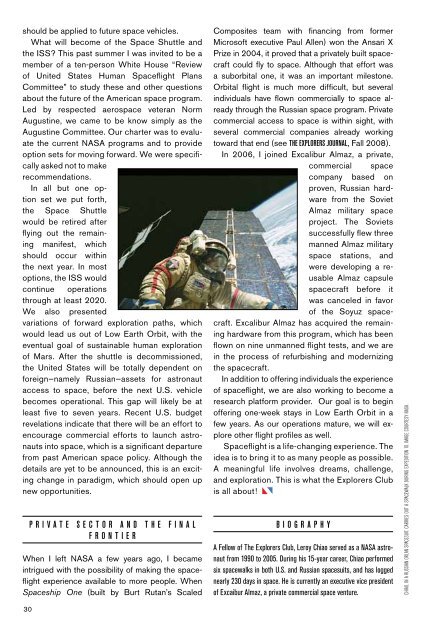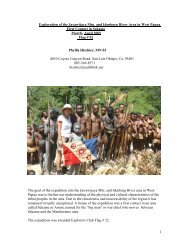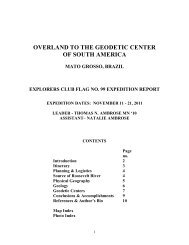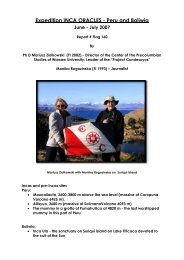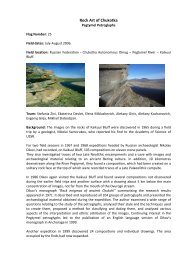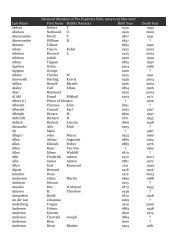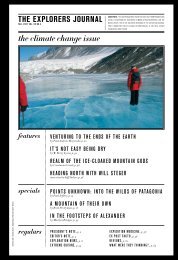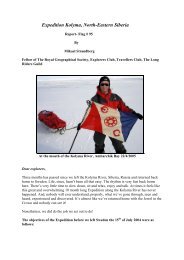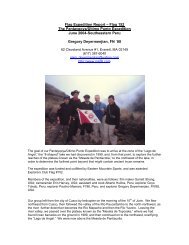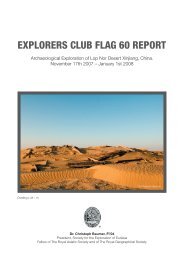the explorers journal - The Explorers Club
the explorers journal - The Explorers Club
the explorers journal - The Explorers Club
You also want an ePaper? Increase the reach of your titles
YUMPU automatically turns print PDFs into web optimized ePapers that Google loves.
should be applied to future space vehicles.<br />
What will become of <strong>the</strong> Space Shuttle and<br />
<strong>the</strong> ISS This past summer I was invited to be a<br />
member of a ten-person White House “Review<br />
of United States Human Spaceflight Plans<br />
Committee” to study <strong>the</strong>se and o<strong>the</strong>r questions<br />
about <strong>the</strong> future of <strong>the</strong> American space program.<br />
Led by respected aerospace veteran Norm<br />
Augustine, we came to be know simply as <strong>the</strong><br />
Augustine Committee. Our charter was to evaluate<br />
<strong>the</strong> current NASA programs and to provide<br />
option sets for moving forward. We were specifically<br />
asked not to make<br />
recommendations.<br />
In all but one option<br />
set we put forth,<br />
<strong>the</strong> Space Shuttle<br />
would be retired after<br />
flying out <strong>the</strong> remaining<br />
manifest, which<br />
should occur within<br />
<strong>the</strong> next year. In most<br />
options, <strong>the</strong> ISS would<br />
continue operations<br />
through at least 2020.<br />
We also presented<br />
variations of forward exploration paths, which<br />
would lead us out of Low Earth Orbit, with <strong>the</strong><br />
eventual goal of sustainable human exploration<br />
of Mars. After <strong>the</strong> shuttle is decommissioned,<br />
<strong>the</strong> United States will be totally dependent on<br />
foreign—namely Russian—assets for astronaut<br />
access to space, before <strong>the</strong> next U.S. vehicle<br />
becomes operational. This gap will likely be at<br />
least five to seven years. Recent U.S. budget<br />
revelations indicate that <strong>the</strong>re will be an effort to<br />
encourage commercial efforts to launch astronauts<br />
into space, which is a significant departure<br />
from past American space policy. Although <strong>the</strong><br />
details are yet to be announced, this is an exciting<br />
change in paradigm, which should open up<br />
new opportunities.<br />
P r i v a t e S e c t o r a n d t h e F i n a l<br />
F r o n t i e r<br />
When I left NASA a few years ago, I became<br />
intrigued with <strong>the</strong> possibility of making <strong>the</strong> spaceflight<br />
experience available to more people. When<br />
Spaceship One (built by Burt Rutan’s Scaled<br />
30<br />
Composites team with financing from former<br />
Microsoft executive Paul Allen) won <strong>the</strong> Ansari X<br />
Prize in 2004, it proved that a privately built spacecraft<br />
could fly to space. Although that effort was<br />
a suborbital one, it was an important milestone.<br />
Orbital flight is much more difficult, but several<br />
individuals have flown commercially to space already<br />
through <strong>the</strong> Russian space program. Private<br />
commercial access to space is within sight, with<br />
several commercial companies already working<br />
toward that end (see <strong>The</strong> <strong>Explorers</strong> Journal, Fall 2008).<br />
In 2006, I joined Excalibur Almaz, a private,<br />
commercial space<br />
company based on<br />
proven, Russian hardware<br />
from <strong>the</strong> Soviet<br />
Almaz military space<br />
project. <strong>The</strong> Soviets<br />
successfully flew three<br />
manned Almaz military<br />
space stations, and<br />
were developing a reusable<br />
Almaz capsule<br />
spacecraft before it<br />
was canceled in favor<br />
of <strong>the</strong> Soyuz spacecraft.<br />
Excalibur Almaz has acquired <strong>the</strong> remaining<br />
hardware from this program, which has been<br />
flown on nine unmanned flight tests, and we are<br />
in <strong>the</strong> process of refurbishing and modernizing<br />
<strong>the</strong> spacecraft.<br />
In addition to offering individuals <strong>the</strong> experience<br />
of spaceflight, we are also working to become a<br />
research platform provider. Our goal is to begin<br />
offering one-week stays in Low Earth Orbit in a<br />
few years. As our operations mature, we will explore<br />
o<strong>the</strong>r flight profiles as well.<br />
Spaceflight is a life-changing experience. <strong>The</strong><br />
idea is to bring it to as many people as possible.<br />
A meaningful life involves dreams, challenge,<br />
and exploration. This is what <strong>the</strong> <strong>Explorers</strong> <strong>Club</strong><br />
is all about!<br />
b i o g r a p h y<br />
A Fellow of <strong>The</strong> <strong>Explorers</strong> <strong>Club</strong>, Leroy Chiao served as a NASA astronaut<br />
from 1990 to 2005. During his 15-year career, Chiao performed<br />
six spacewalks in both U.S. and Russian spacesuits, and has logged<br />
nearly 230 days in space. He is currently an executive vice president<br />
of Excaibur Almaz, a private commercial space venture.<br />
Chiao, in a Russian Orlan spacesuit, carries out a spacewalk during Expedition 10. Image courtesy NASA.


